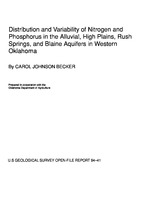Aquifers are the primary source of water for drinking and agricultural purposes in western Oklahoma. Health concerns about consuming nitrogen and an increased reliance on ground water for drinking necessitate a better understanding of the cause and effect of contamination from nutrients. The purpose of this project was to compile nutrients data from the National Water Information System data base for the alluvial aquifers west of longitude 98 degrees W. and from three bedrock aquifers, High Plains, Rush Springs, and Blaine, and provide this information in a report for future projects and for the facilitation of nutrient source management.
The scope of the work consisted of (1) compiling ground-water quality data concerning nitrogen and phosphorus ions, (2) constructing boxplots illustrating data variability, (3) maps for each aquifer showing locations of wells when nitrogen and phosphorus ions were measured in ground water and where concentrations of nitrate and nitrite, reported as nitrogen, exceed the maximum contaminant level, and (4) calculating summary statistics.
Nutrient data were obtained from the U.S. Geological Survey data base called the National Water Information System. Data were restricted to ground-water samples, but no restrictions were placed on well and water use or date and time of sampling.
Compiled nutrient data consist of dissolved and total concentrations of the common nitrogen and phosphorus ions measured in ground water. For nitrogen these ions include nitrate, nitrite, ammonium, and nitrite plus nitrate. All concentrations are reported in milligrams per liter as nitrogen. Phosphorus in ground water is measured as the orthophosphate ion, and is reported in milligrams per liter as phosphorus.
Nutrient variability is illustrated by a standard boxplot. The data are presented by aquifer or hydrologic subregion for alluvial aquifers, with one boxplot constructed for each nutrient compound if more than four analyses are present. Maps for each aquifer show where nitrogen and phosphorus have been measured in ground water and where the concentrations of nitrate and nitrite exceed the maximum contaminant level. A statistical summary for each aquifer and subregion show if censored data were present, number of samples in each data set, largest minimum reporting level for each nutrient compound, percentiles used to construct boxplots, and minimum and maximum values. Also given are the number of wells sampled in each aquifer and the number of wells exceeding the maximum contaminant level.


